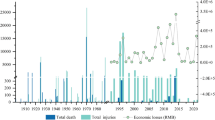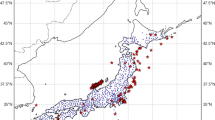Abstract
An accurate prediction of the size of an earthquake is vital to successfully prepare for the disaster and mitigate risks. This study enhances machine learning prediction using spatio-temporal seismic data by combining advanced machine learning models with physical properties, such as energy-depth interactions, which utilize explainable AI approaches. The work highlights the dynamic nature of the seismic pattern by examining four dynamic datasets, emphasizing the need for periodic software updates to maintain effectiveness as models age. The explainability methods based on SHAP are used to investigate feature contributions, allowing for model transparency and actionable insights in terms of important drivers like energy, temperature, and space. Moreover, this has strengthened the operational framework for effective model versioning, tracking of experiments, and deployment, all contributing to the scalability for real-time applications. Overall, this study emphasizes the need to integrate explainable AI, machine learning approaches, and domain knowledge to mitigate the hurdles related to the non-stationarity of earthquake datasets, moving towards resilient, interpretable, and adaptable earthquake prediction solutions.













Similar content being viewed by others
Data Availability
No datasets were generated or analysed during the current study.
References
Abebe E, Kebede H, Kevin M, Demissie Z (2023) Earthquakes magnitude prediction using deep learning for the Horn of Africa. Soil Dyna Earthquake Eng 170:107913
Adeli H, Panakkat A (2009) A probabilistic neural network for earthquake magnitude prediction. Neural Netw 22(7):1018–1024
Asim KM, Martínez-Álvarez F, Basit A, Iqbal T (2017) Earthquake magnitude prediction in Hindukush region using machine learning techniques. Natural Hazards 85:471–486
Asio JMR (2020) Natural calamity, its impact and level of preparations: Significance and implications to the community. Disaster Adv 13(11):22–30
Bentéjac C, Csörgő A, Martínez-Muñoz G (2021) A comparative analysis of gradient boosting algorithms. Artif Intell Rev 54:1937–1967
Feng Y, Wu Q (2022) A statistical learning assessment of Huber regression. J Approx Theory 273:105660
Hans C (2011) Elastic net regression modeling with the orthant normal prior. J American Stat Ass 106(496):1383–1393
Jordan MI, Mitchell TM (2015) Machine learning: Trends, perspectives, and prospects. Sci 349(6245):255–260
Kreuzberger D, Kühl N, Hirschl S (2023) Machine learning operations (MLOps): Overview, definition, and architecture. IEEE Access 11:31866–31879
Li S-Q, Chen Y-S (2023) Vulnerability and economic loss evaluation model of a typical group structure considering empirical field inspection data. Int J Disast Risk Reduct 88:103617
Li S-Q, Gardoni P (2023) Empirical seismic vulnerability models for building clusters considering hybrid intensity measures. J Build Eng 68:106130
Li S-Q, Gardoni P (2024) Optimized seismic hazard and structural vulnerability model considering macroseismic intensity measures. Reliab Eng Syst Safety 252:110460
Li S-Q, Han J-C, Li Y-R, Qin P-F, Chen Y-S (2025) “Estimating the seismic vulnerability of buildings considering modified intensity measures,” in Structures, vol 71, pp 107989,
Li S-Q, Han J-C, Li Y-R, Qin P-F (2025) Intelligent prediction and evaluation models for the seismic risk and vulnerability of reinforced concrete girder bridges in large-scale zones. Reliab Eng Syst Safety 256:110743
Li S-Q, Qin P-F, Chen P-C, Zheng L-L, Zhang C (2024) “Development of seismic risk models for low-rise masonry structures considering age and deterioration effects,” Bulletin of Earthquake Engineering, pp 1–28,
Li S-Q (2024) Seismic risk and vulnerability models considering typical urban building portfolios. Bulletin of Earthquake Eng 22(6):2867–2902
Li S-Q, Chen Y-S, Liu H-B, Del Gaudio C (2023) Empirical seismic vulnerability assessment model of typical urban buildings. Bulletin of Earthquake Eng 21(4):2217–2257
Li S-Q, Liu H-B, Farsangi EN, Du K (2025) Seismic fragility estimation considering field inspection of reinforced concrete girder bridges. Struct Infrastruct Eng 21(2):302–318
Lior I, Ziv A, Madariaga R (2016) "P-wave attenuation with implications for earthquake early warning," *Bull Seismol Soc Am*, vol 106, no 1, pp 13–22
McDonald GC (2009) Ridge regression. Wiley Interdiscipl Rev: Comput Stat 1(1):93–100
Moustra M, Avraamides M, Christodoulou C (2011) Artificial neural networks for earthquake prediction using time series magnitude data or seismic electric signals. Expert Syst Appl 38(12):15032–15039
Ommi S, Hashemi M (2024) Machine learning technique in the north zagros earthquake prediction. Appl Comput Geosci 22:100163
Ozkaya SG, Baygin M, Barua PD, Tuncer T, Dogan S, Chakraborty S, Acharya UR (2024) An automated earthquake classification model based on a new butterfly pattern using seismic signals. Expert Syst Appl 238:122079
Ranstam J, Cook JA (2018) LASSO regression. J British Surg 105(10):1348–1348
Rigatti SJ (2017) Random forest. J Insur Med 47(1):31–39
Vassiliou MS, Kanamori H (1982) The energy release in earthquakes. Bulletin of the Seismologic Soc America 72(2):371–387
Wang Y, Li X, Wang Z, Liu J (2023) Deep learning for magnitude prediction in earthquake early warning. Gondwana Res 123:164–173
Xie S, Wu W, Mooser S, Wang QJ, Nathan R, Huang Y (2021) Artificial neural network based hybrid modeling approach for flood inundation modeling. J Hydro 592:125605
Zaharia M et al (2018) Accelerating the machine learning lifecycle with MLflow. IEEE Data Eng Bull 41(4):39–45
Zhang A, Wang X, Pedrycz W, Yang Q, Wang X, Guo H (2024) Near real-time spatial prediction of earthquake-triggered landslides based on global inventories from 2008 to 2022. Soil Dyna Earthquake Eng 185:108890
Zhang W, Wen J, Dong H, Han Q, Du X (2025) Post-earthquake functionality and resilience prediction of bridge networks based on data-driven machine learning method. Soil Dyna Earthquake Eng 190:109127
Zhang T, Xu W, Wang S, Du D, Tang J (2024) "Seismic response prediction of a damped structure based on data-driven machine learning methods," *Eng Struct*, vol 301, p 117264
Zheng Y, Zhang H, Yu Y (2015) “Detecting collective anomalies from multiple spatio-temporal datasets across different domains,” Proceed 23rd SIGSPATIAL Int Conf Adv Geograph Inf Syst, pp 1–10
Acknowledgements
The authors wish to thank the Indian Seismology Department (seismo.gov.in) for providing access to seismic data and VisualCrossing (visualcrossing.com) for providing the weather datasets used in this research. Many of these datasets would not have been accessible without the authors of those papers, and I hold gratitude to them and their respective contributions in making these open-access datasets available, which have been vital for the success of this work. The authors acknowledge the efforts of the open-source community whose tools and frameworks, specifically MLflow, have proven essential in constructing the MLOps pipeline and integration of machine learning models in this work.
Funding
This research has not received any grant from any funding agency in the public, commercial, or not-for-profit sectors.
Author information
Authors and Affiliations
Contributions
Rahul Singh wrote the main manuscript, methodology and plot the figures. Bholanath Roy supervise the complete process and help to refine the methodology section.
Corresponding author
Ethics declarations
Competing Interests
The authors declare no competing interests.
Additional information
Communicated by: Hassan Babaie.
Publisher's Note
Springer Nature remains neutral with regard to jurisdictional claims in published maps and institutional affiliations.
Rights and permissions
Springer Nature or its licensor (e.g. a society or other partner) holds exclusive rights to this article under a publishing agreement with the author(s) or other rightsholder(s); author self-archiving of the accepted manuscript version of this article is solely governed by the terms of such publishing agreement and applicable law.
About this article
Cite this article
Singh, R., Roy, B. Explainable earthquake magnitude prediction with hybrid modeling and spatio-temporal data for scalability. Earth Sci Inform 18, 355 (2025). https://doi.org/10.1007/s12145-025-01867-0
Received:
Accepted:
Published:
DOI: https://doi.org/10.1007/s12145-025-01867-0




